Pool Training
Swimming pools provide a warm and safe environment to prepare you for open water swimming.
Whether you are a novice swimmer who would like the confidence to take a dip outdoors, or a competent pool swimmer preparing for your first open water swim, or even someone who has already experienced the thrill of open water and keen to improve your skills and progress, hopefully there will be useful information here.
This training is intended for intermediate swimmers. If you can’t go to the pool 3 times a week, just go as much as you can and keep the plan as it is session after session. Follow it through and see your swimming skills get better.
Getting away from following the black line at the bottom of the pool can reinvigorate your swimming. Prepare for the transition to your local lake, reservoir, or ocean, with these training and safety tips.
Adjusting to the unpredictable open water can be a challenge for swimmers who spend most of their training in the controlled environment of a pool. Before you hit the open water, incorporate specific activities into your training to make the transition easier and safer. Wading is a good practice to build up lower body strength. Walk in chest deep water several widths of the pool with your arms in the water to control resistance. Footballers use this technique to stay fit.
Close your eyes. Swim 8 to 10 strokes in the pool with your eyes closed, then look above the water. This will help you learn to swim straight without using the bottom of the pool as a guide.
Be Efficient. Make it a goal to lower your stroke count per lap to swim more efficiently. Try a workshop or lessons for some new perspective. Wear your open water swim clothes in the pool to get used to their additional drag and weight.
Swim like a dolphin. Practice short dolphin dips from a standing position once in the shallow water. Push forward off the bottom in a series of short dives to propel yourself through shallow water. This way you learn to get in and out of open water more quickly than running through the water. Never dive in from the side of the pool.
Sight-breathing in the pool will help train the muscles you need to lift your head.
Lift your head up to look forward in rhythm with your breathing.
Look up every eight strokes, eyeing a target past the end of the lane;
a window, deck chair or a lifeguard will do.
Gradually work up to more strokes between sight-checks with regular practice.
Resistance swim training teaches you to conserve your energy by optimising your swim strokes,
and continue swimming for longer to meet your goal.
While you swim in minimal swimwear, you can get away with very bad swimming strokes. Almost anything works to some degree. Just look at a busy pool to notice this.
When you swim fully clothed with a bad stroke you may not move much at all. This is where you can now tweak your technique and get immediate feedback on what works. Rapid progress can be made in little time.
Fartlek, or speed play, is an excellent way to mimic what really happens during an open water swim. Whether you need to swim around a slower swimmer or pick up the pace to draft another person or group, it is easy to incorporate this into your regular training without adding time.
For example, during your long swim sessions, pick up the pace for short bursts, anywhere from 25 to 100 meters, then settle back into your planned session pace. For the best results, start when you're away from the wall to simulate being in open water as much as possible.
It's also a good idea to occasionally stop during one of these repeats, just like you might do when enjoying the scenery outdoors. This way, you can practice a deep water start and speed play at the same time.
Prepare for Outdoors
Most outdoor swimmers achieve the longer distances more easily. When you swim outdoors, consider the key differences between pool and open water swimming.
Main factors that influence your open water distance are:
- Temperature
- Weather
- Navigation
- Buoyancy
- Clothing
Try out new swim clothes in the pool before using them in open water.
Even with clothes you already own, wear them for a few pool practices first.
The pool provides a safe and comfortable environment to adjust for the way
the clothes change your feel for the water and body position.
Check with the manufacturer to make sure the chemicals in the pool won't deteriorate the material.
Pool Training Tips
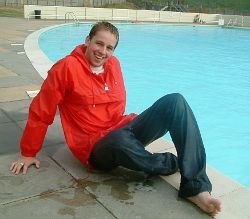
Long pants and anorak are good pool training clothes and easy to swim in. The nylon fabric doesn't clog up the pool filters with fluff.
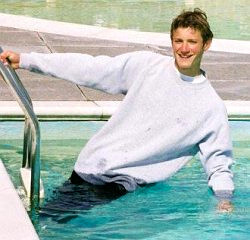
A fleece pullover soaks up water and gets heavy when wet. Good for strength training.
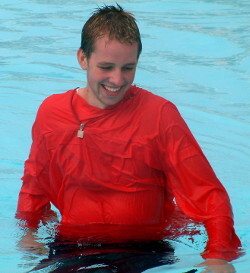
An anorak is lightweight but causes a fair bit of drag.
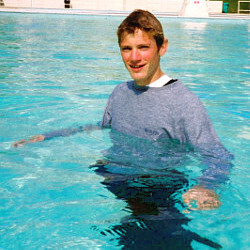
Clothes slow you down, but don't pull you down. This awareness is important for safe water sports.
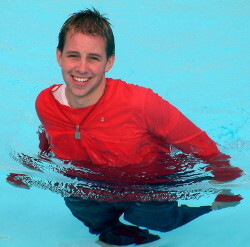
Shallow water wading gives you a feel for the drag resistance when you move around.
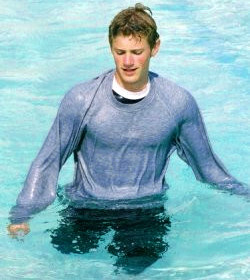
Wading helps to build up leg muscles and lower body strength.

Swimming a few lengths lets you see how well your clothes fit. This is important for your safety.

A comfy swimsuit makes a good base layer so you can change into different clothes on poolside.
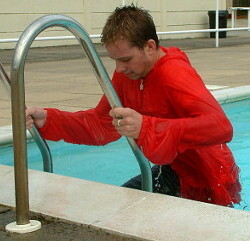
As you climb out you'll notice how much waterlogged clothes weigh.
Reader Comment
Good Training for Beginners
from Joey, Bangkok, ThailandThis is a great fun training for anyone who starts out with survival training. In our team we ask new swimmers to wear at least t-shirt and shorts, so it kind of mimics having some workout clothing on. Get permission first and check the dress code. Pool operators prefer you to wear man-made fibres that don't clog up the pool filters.
Gradually they wear more kit in the water to train at a higher level, like sweatshirt, hoodies and long pants. Finally they can do it in full gear.
Training Tip:
Write down your weekly training results.
Time your swims.
Add more clothing layers over time.
Compare notes.
You should see improvements.
It builds massive aquatic confidence.